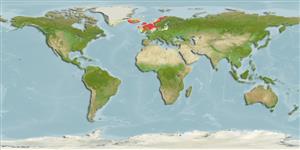Teleostei (teleosts) >
Perciformes/Scorpaenoidei (Scorpionfishes) >
Sebastidae (Rockfishes, rockcods and thornyheads) > Sebastinae
Etymology: Sebastes: Greek, sebastes = august, venerable (Ref. 45335).
Environment: milieu / climate zone / depth range / distribution range
Ecology
Marine; demersal; depth range 50 - 300 m (Ref. 35388). Temperate; 71°N - 50°N, 50°W - 21°E
Northeast Atlantic: Norwegian coast from Kattegat to Tanafjord in Finnmark, rare off Bear Island, northern part of North Sea, around Shetland Islands, Scotland, northern England, Wales and Ireland, rare in the English Channel; Rockall Bank, common around Faroes and Iceland; sporadic off East Greenland.
Length at first maturity / Size / Weight / Age
Maturity: Lm 12.5, range 10 - 15 cm
Max length : 66.5 cm TL male/unsexed; (Ref. 106276); common length : 25.0 cm TL male/unsexed; (Ref. 4570); max. published weight: 1.0 kg (Ref. 35388); max. reported age: 40 years (Ref. 35388)
Inhabit rocky bottoms, close to the shore, between 10 and 150 m, but also recorded at 760 m (Ref. 4570). Live in shoals and moves closer to the shore in the summer (Ref. 35388). Feed on various small crustaceans and young fishes (Ref. 4570). Viviparous (Ref. 34817).
Ovoviviparous.
Wheeler, A., 1992. A list of the common and scientific names of fishes of the British Isles. J. Fish Biol. 41(suppl.A):1-37. (Ref. 5204)
IUCN Red List Status (Ref. 130435: Version 2024-1)
Threat to humans
Harmless
Human uses
Fisheries: commercial
Tools
Special reports
Download XML
Internet sources
Estimates based on models
Preferred temperature (Ref.
123201): 6.8 - 9.8, mean 7.8 °C (based on 186 cells).
Phylogenetic diversity index (Ref.
82804): PD
50 = 0.5000 [Uniqueness, from 0.5 = low to 2.0 = high].
Bayesian length-weight: a=0.01148 (0.00728 - 0.01811), b=3.05 (2.92 - 3.18), in cm total length, based on LWR estimates for this species & Genus-body shape (Ref.
93245).
Trophic level (Ref.
69278): 4.0 ±0.67 se; based on food items.
Generation time: 15.7 ( na - na) years. Estimated as median ln(3)/K based on 1
growth studies.
Resilience (Ref.
120179): Very Low, minimum population doubling time more than 14 years (K=0.07; tm=20; tmax=40).
Fishing Vulnerability (Ref.
59153): High to very high vulnerability (71 of 100).
Climate Vulnerability (Ref.
125649): High to very high vulnerability (71 of 100).
Nutrients (Ref.
124155): Calcium = 16 [7, 45] mg/100g; Iron = 0.175 [0.079, 0.422] mg/100g; Protein = 17.7 [16.5, 19.1] %; Omega3 = 0.883 [0.338, 2.408] g/100g; Selenium = 43.3 [17.5, 116.9] μg/100g; VitaminA = 10.7 [2.4, 47.4] μg/100g; Zinc = 0.331 [0.174, 0.567] mg/100g (wet weight);
